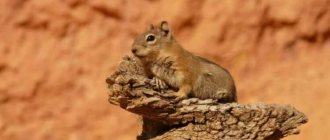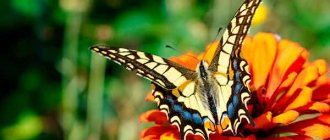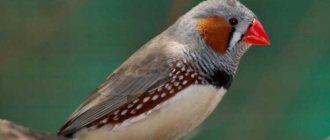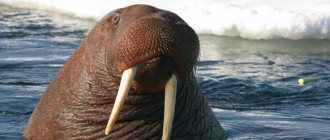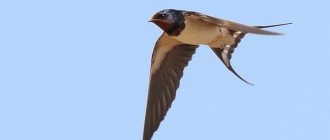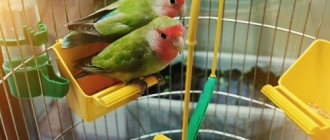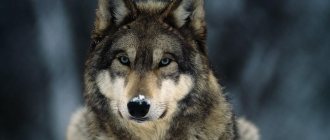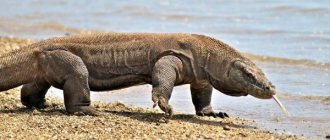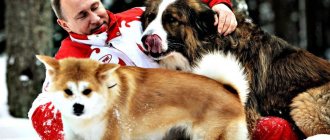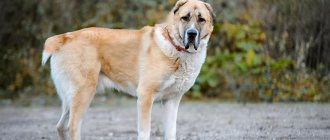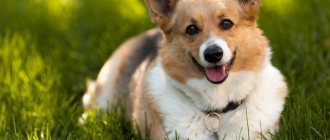- Where do penguins live
However, not only the indigenous people
Antarctica is home to these amazing birds, since penguins also live, for example, in... Africa (yes, such a paradox), but only in its southernmost part, on the territory of South Africa (South Africa). These flightless birds with interesting habits and unusual appearance have long been the object of study by many zoologists, the heroes of children's cartoons (such as Madagascar). The word “penguin” itself, according to one version, is of Welsh origin and comes from the words “pen” - head and “gwyn” - white, which was the original name for the now extinct great auk, which was very similar to penguins, and this name later passed on to them. According to another version, the name “penguin” comes from the English “pinwing”, which means wingspin. And finally, according to the third version, the name of penguins is of Latin origin, since in Latin the word “pinguis” means “fat”.
Description, structure, characteristics
All penguins, without exception, are first-class swimmers, and they also know how to dive well. But, unfortunately, they literally cannot fly at all. And on the ground they move very clumsily due to the structural features of their body.
The penguin's body has a streamlined shape and developed muscles of the pectoral keel, which sometimes makes up a quarter of the total mass of this bird. Also, the body of penguins is usually quite plump (here we remember the Latin name of this bird) and covered with feathers on the sides.
The penguin's head is not very large, however, it is located on a mobile, flexible and short neck and has a powerful and sharp beak.
Why does a penguin need wings if it can't fly? Such a logical question may arise, and we will answer it, the fact is that the penguin’s wings, in the process of evolution, were transformed into flippers, which, while swimming, rotate in the shoulder joint like a screw, all this turns the penguin into an excellent swimmer.
The penguin's legs are short and at the same time thick, each leg has 4 toes, connected by swimming membranes. It is the structure of their legs that leads to the fact that penguins move so funny and clumsily; they are designed in such a way that they always have to keep their body strictly vertical to the surface of the earth.
Penguins also have a short tail, consisting of 16-20 feathers, which helps them maintain balance and, if necessary, they can even lean on it like a stand.
The skeleton of a penguin, unlike other birds, does not consist of hollow tubular bones; the bones of a penguin are more similar to the bones of mammals. The harsh Antarctic cold helps penguins endure a warming reserve of fat, which has a layer of 2-3 centimeters.
The plumage of penguins is thick and dense; the body of the bird is covered with feathers like tiles, which also protect them from getting wet in cold water. The color of the feathers and the penguins themselves is the same - a dark back and a white belly.
About once a year, penguins molt, old feathers fall out, and new ones grow in their place. During this period, penguins are located exclusively on land, where they try to shelter as much as possible from gusts of wind and generally cold weather.
Penguin during molting.
The sizes of penguins vary depending on their species, so the largest, the emperor penguin, is 117-130 cm long and weighs up to 40 kg. The little penguin reaches only 40 cm in length and weighs on average about 1 kg.
Natural enemies of penguins
As a rule, penguins live in isolated areas and while on land they are protected from many predators. The only danger that can lurk for both adults and cubs is animals that people bring to this territory for a number of reasons. These include dogs and cats.
This does not mean at all that penguins are completely defenseless: they have a fairly sharp beak and powerful fins, which are quite effective weapons. Chicks suffer from petrels if their parents are left unattended. There are also some species of seagulls that will feast on penguin eggs at the first opportunity.
When penguins are in the waters of the world's oceans or seas, they are hunted by killer whales, sharks, sea lions and fur seals. Seals almost constantly patrol the waters in the immediate vicinity of penguin colonies. Unfortunately, seals have a huge advantage because they are much more maneuverable than penguins, so scientists estimate that up to 5 percent of Adelie penguins die in such conditions.
Interesting moment! Due to the presence of marine predators, penguins do not like the aquatic environment, although they are perfectly adapted to life in this environment.
They do not dive into the water until they have examined the coast for natural enemies. They can approach the water in small groups and wait for something, not daring to dive into the water. This can last up to half an hour. They all start diving after a brave penguin is found and dives first.
Habitats
Penguins are omnivorous birds, so their diet includes various sea fish, crayfish, plankton, and small mollusks. Small
Octopus and squid can also become food for the penguin. Penguins get their prey in the water, because it’s not for nothing that they are excellent swimmers. During a hunt, a penguin can make up to 900 dives; the penguin's speed in the water can reach up to 10 km per hour. During sea hunting, the beak of a penguin works on the principle of a pump; it sucks in all small prey along with water.
What do they eat
The diet of penguins is based on fish, crustaceans, plankton, as well as small representatives of cephalopods. Penguins happily eat anchovies and krill, sardines, Antarctic silverfish, squid and small octopuses. When these sea creatures hunt, they can make almost a thousand dives. The number of such dives depends on climatic conditions, as well as on species characteristics and the availability of food supply.
Interesting fact! Representatives of penguins have to drink mostly salty sea water. As a result, excess salt appears in the animals’ bodies, which is excreted through special glands that are located above the eyes.
During the feeding process, these animals suck their prey into the oral cavity along with a certain amount of water. Therefore, salt water always enters the body of animals in excess. According to scientists' observations, while feeding, penguins travel up to 30 kilometers across the sea surface, while at a depth of more than 3 meters they spend up to an hour and a half a day.
Lifestyle
The most interesting feature regarding the lifestyle of these birds is the fact that matriarchy dominates penguin society. It is the female penguins who choose the males they like, care for them, seek their recognition, then the males, in turn, hatch the eggs, while the females get food. In general, the roles of gender relations in penguins are diametrically opposed to many other representatives of the animal world.
Penguins are collective creatures and do not just live in families or flocks, but form entire bird colonies that can reach up to a million individuals. And on Zavadovsky Island, located in the South Atlantic, the world's largest colony of chinstrap penguins is known; according to rough estimates, about 10 million of these birds live there.
Penguins love to be in the company of their own kind, but during the mating season for procreation, the male and female temporarily leave the company of their relatives and return back with a newborn baby, but we will write about this in more detail below.
penguin-2204566_1920.jpg
Photo from pixabay.com
What threatens penguins?
Today, three species of penguin are on the verge of extinction: crested, magnificent and Galapagos, and seven more species are in danger. Thus, Antarctic species suffer from melting ice, New Zealand and Australian penguins are attacked by wild mammals, such as cats and dogs, brought by people. Penguins living near a port in South Africa have been exposed to oil pollution, and the Galopogos penguin population has been reduced by travelers feeding on the birds' eggs.
Types, photos and names
According to the modern classification, there are 6 genera and 19 species of penguins in the world; we will describe the most interesting of them.
Emperor penguin
This representative of the penguin kingdom is the most majestic (it’s not for nothing that it has such a name) and the largest: the weight of the emperor penguin reaches 40 kg with a height of up to 115 cm. Emperor penguins live exclusively on the coast of Antarctica. (By the way, we have an interesting article about them on our website - “
Emperor penguins are eternal exiles in the ice,” follow the link).
King Penguin
It is very similar to its imperial relative, but is somewhat inferior in size: its height, on average, is 90-100 cm, with a weight of 10-18 kg. It also differs in the color of its feathers: the back is dark gray, sometimes almost black, the belly is white, as befits penguins, and there are bright orange spots on the sides of the head. King penguins live on many islands in the South Atlantic.
Adelie Penguin
These penguins are medium in size, Adélie is 65-75 cm long and weighs 6 kg. Another distinctive feature of this species is the presence of white rings around the eyes. Adélie penguins live in Antarctica and some adjacent islands (Orkney, South Scotland).
Northern crested penguin
A distinctive feature of the northern crested penguin is the presence of tufts of black and yellow feathers on its head, giving the bird a more than unusual appearance. The size of this penguin is 55 cm in length and weighs up to 3 kg. It lives on a number of islands in the South Atlantic; nowadays, unfortunately, it is endangered.
Golden haired penguin
In appearance, it is almost identical to other penguins, but has one interesting feature - a bunch of golden feathers flaunts above its head (hence its name). The body length and weight are slightly greater than that of the crested penguin: length - 60-70 cm, weight - 5-6 kg. It also lives in the southern Atlantic and Indian Ocean.
Gentoo penguin
This penguin takes an honorable second place after the emperor, in terms of size, its length reaches 90 cm, weight – up to 9 kg. Another characteristic feature of this type of penguin is their beak, which is colored orange-red.
Magellanic penguin
The Magellanic penguin, as its name suggests, lives in the Strait of Magellan in South America. The body length of the Magellanic penguin is 70-80 cm, with a weight of 5-6 kg. The coloring of these penguins is characterized by the presence of one or two black stripes around the neck.
Chinstrap penguin
This penguin, which lives on the coast of Antarctica and adjacent islands, in addition to its signature penguin coloring, has an additional black stripe that runs along its head. Its length is 60-70 cm and its weight is 4-5 kg.
Spectacled penguin
Also known as the donkey penguin, black-footed penguin, or African penguin. Unlike its counterparts living in cold Antarctic conditions, this penguin lives in South Africa, on the territory of South Africa (South African Republic), they are also found on the coasts of neighboring Namibia, but only in places where there is a cold ocean current. These penguins are also distinguished from their relatives by a narrow black horseshoe-shaped stripe located on their chest.
Little Penguin
This type of penguin is the smallest in the penguin family, its height is no more than 40 cm, with a weight of up to 1 kg. These small penguins live on the coasts of Australia, New Zealand, Tasmania and the adjacent islands.
Bird distribution
Marked places on the map where penguins live
Penguins are common in the open seas of the Southern Hemisphere (coastal waters of Antarctica, New Zealand, southern Australia, South Africa, on the coast of South America from the Falkland Islands to Peru, on the Galapagos Islands).
These birds prefer cool climates, so they can appear in tropical latitudes only with cold currents
The warmest place where penguins live is the Galapagos Islands, which are located near the equator.
Reproduction
We touched a little on how penguins reproduce in the section on their lifestyle, now we’ll talk about this in even more detail. Firstly, matriarchy prevails among penguins, and females choose males for mating, and not vice versa. Secondly, penguins are monogamous and mate for life.
Penguins reach sexual maturity after two years. So, with the onset of the mating season, young females choose a suitable male for themselves, and retire with him to mate. As a result of this, after a certain time, the female appears 1-2 eggs (in rare cases there may be three). But it is not the mother, but the father penguin who is incubating the eggs and taking care of them. At this time, the female is engaged in obtaining food, both for herself and for her “husband”, who is busy with an extremely important task.
After about 30-100 days (depending on the type of penguin), small chicks hatch from the eggs; they are at first blind, and only after several weeks do they begin to see. Despite the care and protection of their parents, approximately 60% of the chicks die from hunger, cold and attacks by birds of prey - skuas, who love to feast on penguin chicks.
Before their first molt, the little penguin chicks are exclusively on land; only with the appearance of thick, waterproof plumage can they dive into the water.
As they grow older, little penguins begin to unite in small groups, which zoologists call a kind of “kindergarten” for penguins. This association also has practical significance, since in a group it is easier for young penguins to protect themselves from predatory skuas.
Classification of the Penguin family (Spheniscidae)
The order Sphenisciformes includes the only modern family - Penguins, or Penguins (Spheniscidae), in which 6 genera and 18 species are distinguished (according to the datazone.birdlife.org database from November 2018).
Genus Aptenodytes JF Miller, 1778 - Emperor penguins
- Aptenodytes forsteri R. Gray, 1844 - Emperor penguin
- Aptenodytes patagonicus F. Miller, 1778 - King Penguin
Genus Eudyptes Vieillot, 1816 - Crested penguins
- Eudyptes chrysocome (JR Forster, 1781) - Crested penguin, golden-crested rock penguin
- Eudyptes chrysolophus (JF von Brandt, 1837) - Golden-haired penguin
- Eudyptes moseleyi Mathews & Iredale, 1921 - Northern crested penguin
- Eudyptes pachyrhynchus R. Gray, 1845 - Victoria penguin
- Eudyptes robustus Oliver, 1953 - Snar's crested penguin
- Eudyptes schlegeli Finsch, 1876 - Schlegel's Penguin
- Eudyptes sclateri Buller, 1888 - Great crested penguin
Genus Eudyptula Bonaparte, 1856 - Little penguins
- Eudyptula minor (JR Forster, 1781) - Lesser penguin
Genus Megadyptes Milne-Edwards, 1880 - Magnificent Penguins
- Megadyptes antipodes (Hombron & Jacquinot, 1841) - Yellow-eyed penguin, or magnificent penguin
Genus Pygoscelis Wagler, 1832 - Chinstrap penguins
- Pygoscelis adeliae (Hombron & Jacquinot, 1841) - Adelie Penguin
- Pygoscelis antarcticus (JR Forster, 1781) - Chinstrap penguin
- Pygoscelis papua (JR Forster 1781) - Gentoo (subantarctic) penguin
Genus Spheniscus Brisson, 1760 - Spectacled penguins
- Spheniscus demersus (Linnaeus, 1758) - Spectacled penguin
- Spheniscus humboldti Meyen, 1834 - Humboldt penguin
- Spheniscus magellanicus (JR Forster, 1781) - Magellanic penguin
- Spheniscus mendiculus Sundevall, 1871 - Galapagos penguin
Interesting Facts
penguins-3994532_1920.jpg
Photo from pixabay.com
Phenology is the science of seasonal natural phenomena, the timing of their occurrence and the reasons that determine these timings. Thanks to the portal of the Russian Geographical Society “Phenological Network”, everyone has the opportunity to mark their observations on the map, add characteristics of the place, type of phenomenon, description, photographs, and even assess the condition of the natural object. The information collected from users from different regions is of great scientific value, especially taking into account the long history of phenological observations of the Russian Geographical Society, conducted since 1848.
Video
And in conclusion, an interesting documentary about the difficult life of emperor penguins.
Author: Pavel Chaika, editor-in-chief of Poznavaika magazine
When writing the article, I tried to make it as interesting, useful and high-quality as possible. I would be grateful for any feedback and constructive criticism in the form of comments on the article. You can also write your wish/question/suggestion to my email [email protected] or Facebook, with respect, the author.
Author page
This article is available in English -
Penguins – Inhabitants of Antarctica.
izobrazhenie_barbara_dougherty_s_sayta_pixabay_-emperor-penguins-2821897_1920.jpg
Photo from pixabay.com
How to learn more about penguins?
Traditionally, photo exhibitions, lectures, master classes and documentary film screenings are held around the world on Penguin Awareness Day. Similar themed events will be held on April 25, World Penguin Day.
One of these events will take place at the Darwin Museum. Guests of the holiday will go on a real Antarctic expedition. They will get acquainted with the geography and history of the discovery of Antarctica, its unique inhabitants, and gain the skills necessary for polar explorers. The holiday will take place on February 1st.
In the meantime, you can test your knowledge about these unusual and charming birds by taking a test from the Russian Geographical Society and the Phenological Network of the Russian Geographical Society .
Inhabitants of Africa
The African penguin holds the record for names. He is called a donkey because his voice is very similar to the cry of a donkey. The second name is spectacled, because of the circles around the eyes. It is also called black-footed because its paws are black.
In South Africa it is one of the main living attractions. On the upper part of the chest, each spectacled penguin has a horseshoe-shaped design. The most interesting thing is that these drawings are as unique as a person’s fingerprints.
Adele
Author: Stan Shebs.
The beautiful flightless sea bird received its specific name thanks to the French navigator and explorer Jules Dumont-Durville.
He named the new species after his wife. Take a closer look, there is a certain French charm in this penguin. Based on it, Japanese and Soviet animators drew the little penguin Lolo. This Antarctic species inspired the creators of all parts of Madagascar. Children and adults immediately fell in love with the Madagascar mischief-makers.
Hockey club mascot
The National Hockey League club from Pittsburgh has been called the Hornets since its founding. But the club owner didn’t like the name.
In 1967, a competition was held among fans, and 700 out of 26 thousand people suggested the name “Penguin”. This is how the Pittsburgh Penguins began playing in the NHL. The editors of most-beauty wish the penguins with hockey sticks many wonderful victories!
